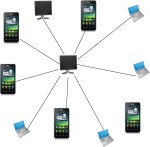Look Up Exaggerates Damages of Social Media uses science to dismantle the claims in the viral video “Look Up” made by Gary (aaaand no, I’m not linking to it).
They put claims such as ” We share frivolous bits of ourselves on social media, but leave out anything meaningful” up against current literature and find the claims ring as hollow as an empty keg. The sources they cite are diverse including: danah boyd, Kowert, Griffiths, and Oldmeadows article on “geek” stereotypes, the New York Times, Pew Research Center’s Internet and American Life Project, and Deters and Mehl’s article on how Facebook can make us feel less lonely. They wrap up by citing an article from Slate.com which not only recaps technohysteria of the 20th century but also reminds the reader of the Douglas Adams comment that any new technology will be regarded with suspicion and trepidation by people 35 or older.
Le sigh.
My generation? We embraced 24/7 MTV and the the Sony Walkman with gusto. However,the Nervous Nellies of my youth intoned that these communication advances would erode our morals and make us socially disconnected narcissists. And now I see so many of us spouting those same arguments about computer and/or mobile media. Has my generation become our our parents at their most hand wringingest?
(Well, some of us, your gentle blog writer refuses to succumb to that kind of thinking.)
This cyberhysteria is the latest incarnation of panic over technology. Marvin’s When Old Technology Was New (1988) is a good book that tackles this topic with full force. She spells out how in the 19th and 20th centuries, electricity, the telephone, telegraph. the radio and television were subject to the same fear and hysteria as computer and mobile media is today.
Our most advanced consumer technology serves at the whim of its owners. I’m not a utopianist but a realist, we control our technology and that means that we have the lion’s share of control over what it does to us, our families and our children. On its own technology isn’t not good or bad, it’s tool and like a hammer it can be used to build or destroy.
Take a deep breath Gary, now exhale. There, that’s better isn’t it?


